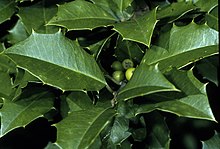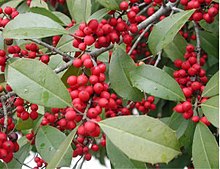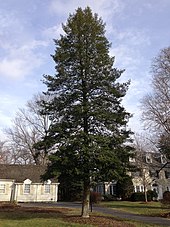Ilex opaca
| Ilex opaca | |
|---|---|

| |
| Foliage and immature fruit | |
| Scientific classification | |
| Kingdom: | Plantae |
| Clade: | Tracheophytes |
| Clade: | Angiosperms |
| Clade: | Eudicots |
| Clade: | Asterids |
| Order: | Aquifoliales |
| Family: | Aquifoliaceae |
| Genus: | Ilex |
| Species: | I. opaca
|
| Binomial name | |
| Ilex opaca | |

| |
| Natural range of Ilex opaca | |
| Synonyms[3] | |
| |
Ilex opaca, the American holly, is a species of holly, native to the eastern and south-central United States, from coastal Massachusetts south to central Florida, and west to southeastern Missouri and eastern Texas.[4][5]
Description
Ilex opaca is a medium-sized broadleaved evergreen tree growing on average to 10–20 m (33–66 ft) wide, and up to 30 m (98 ft) tall. Typically, its trunk diameter reaches 50 cm (20 in), sometimes up to 120 cm (47 in). The bark is light gray, roughened by small warty lumps. The branchlets are stout, green at first and covered with rusty down, later smooth and brown. The winter buds are brown, short, obtuse or acute. The branches are short and slender. The roots are thick and fleshy.
The

The
, four-lobed; ovules one or two in each cell.The fruit is a small red drupe 6–12 mm diameter containing four seeds; it is often persistent into winter.[4][7][8]

A ratio of three female plants to one male plant is required for ideal fruit production.[11]
Taxonomy
It has four recognized subspecies/variations:[3]
- Ilex opaca subsp. arenicola (Ashe) A.E. Murray
- Ilex opaca var. laxiflora (Lam.) Nutt.
- Ilex opaca subsp. opaca
- Ilex opaca var. opaca
Ecology
Due to its shade tolerance, Ilex opaca typically grows as an
The flowers are
Cultivation and uses
The wood is very pale, tough, close-grained, takes a good polish, and is used for whip-handles, engraving blocks and also cabinet work. It can also be dyed and used as a substitute for ebony. It has a density of 0.58 to 0.64.[clarification needed] The sap is watery, and contains a bitter substance used as an herbal tonic.[4][8]
Leaves from the American holly can be used to make a tea-like beverage. American holly tea does not contain caffeine.[16][unreliable source?]

Ornamental plant
Ilex opaca is often cultivated by
The holly in winter

Holly is a popular winter Christmas and holiday season decoration. To Christians, the thorny foliage is attributed to the crown of thorns Christ wore, the berries represent his drops of blood, and the evergreen represents life after death.[18] In English poetry and English stories the holly is inseparably connected with the merry-making and greetings which gather around the Christmas time. The custom is followed in North America, and holly and mistletoe are widely used for decoration of homes and churches.
The European holly is smaller than the American holly, but is closely related and closely resembles it. The leaves of both species are similar in outline and toothed and bristled very much the same way, but the leaves are brighter in the American holly and larger.[citation needed] The American holly, called the evergreen or Christmas holly (Ilex opaca Aiton) was named the state tree of Delaware on 1 May 1939.[19]
References
- . Retrieved 19 November 2021.
- ^ "NatureServe Explorer". Retrieved 2021-05-03.
- ^ a b The Plant List, Ilex opaca Aiton
- ^ a b c d e f Grelen, H. E. (1990). "Ilex opaca". In Burns, Russell M.; Honkala, Barbara H. (eds.). Hardwoods. Silvics of North America. Vol. 2. Washington, D.C.: United States Forest Service (USFS), United States Department of Agriculture (USDA) – via Southern Research Station.
- ^ "Ilex opaca". County-level distribution map from the North American Plant Atlas (NAPA). Biota of North America Program (BONAP). 2014.
- ^ ISBN 0-333-47494-5.
- ^ a b Oklahoma Biological Survey: Ilex opaca
- ^ a b c d e Keeler, H. L. (1900). Our Native Trees and How to Identify Them. New York: Charles Scribner's Sons.
- ^ "Holly Berries". www.poison.org. Retrieved 2021-03-05.
- ISBN 9781561644742.
- ^ "Plant Database". hort.uconn.edu. Retrieved 2019-02-17.
- ^ "American holly (Ilex opaca) - Climate Change Atlas". www.fs.fed.us. Retrieved 2019-02-18.
- ^ "Ilex opaca Ait". www.fs.fed.us. Retrieved 2019-02-18.
- ^ "Ilex opaca (American Holly, English Holly, European Holly, Holly, Inkberry, Oregon Holly, Winterberry) | North Carolina Extension Gardener Plant Toolbox". plants.ces.ncsu.edu. Retrieved 2021-03-05.
- ISBN 0-394-50760-6.
- ^ "Hollies: Caffein & Antioxidants". Eat the Weeds. 2014-12-07.
- ^ "Ilex × attenuata 'Fosteri'". Plant Finder. Missouri Botanical Garden. Retrieved 6 December 2020.
- ISSN 1999-4907.
- ^ "Delaware Code Title 29 § 305".


